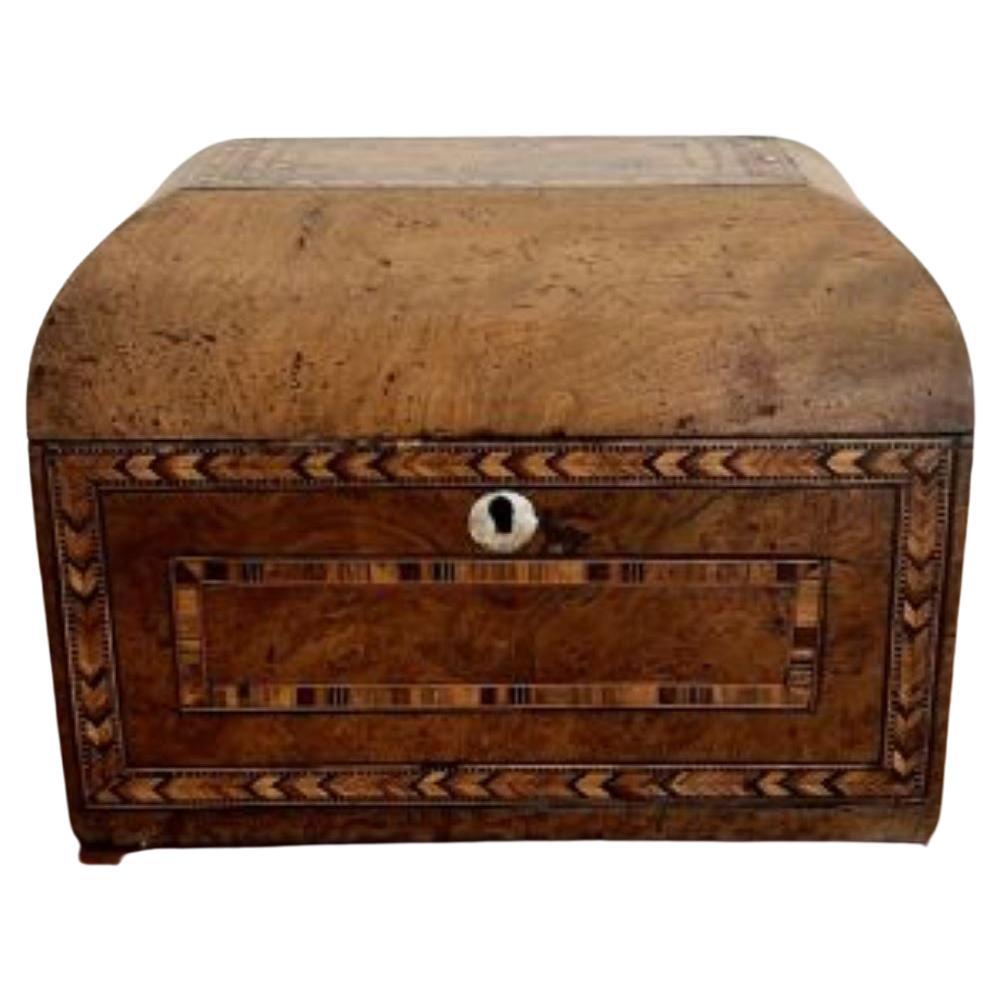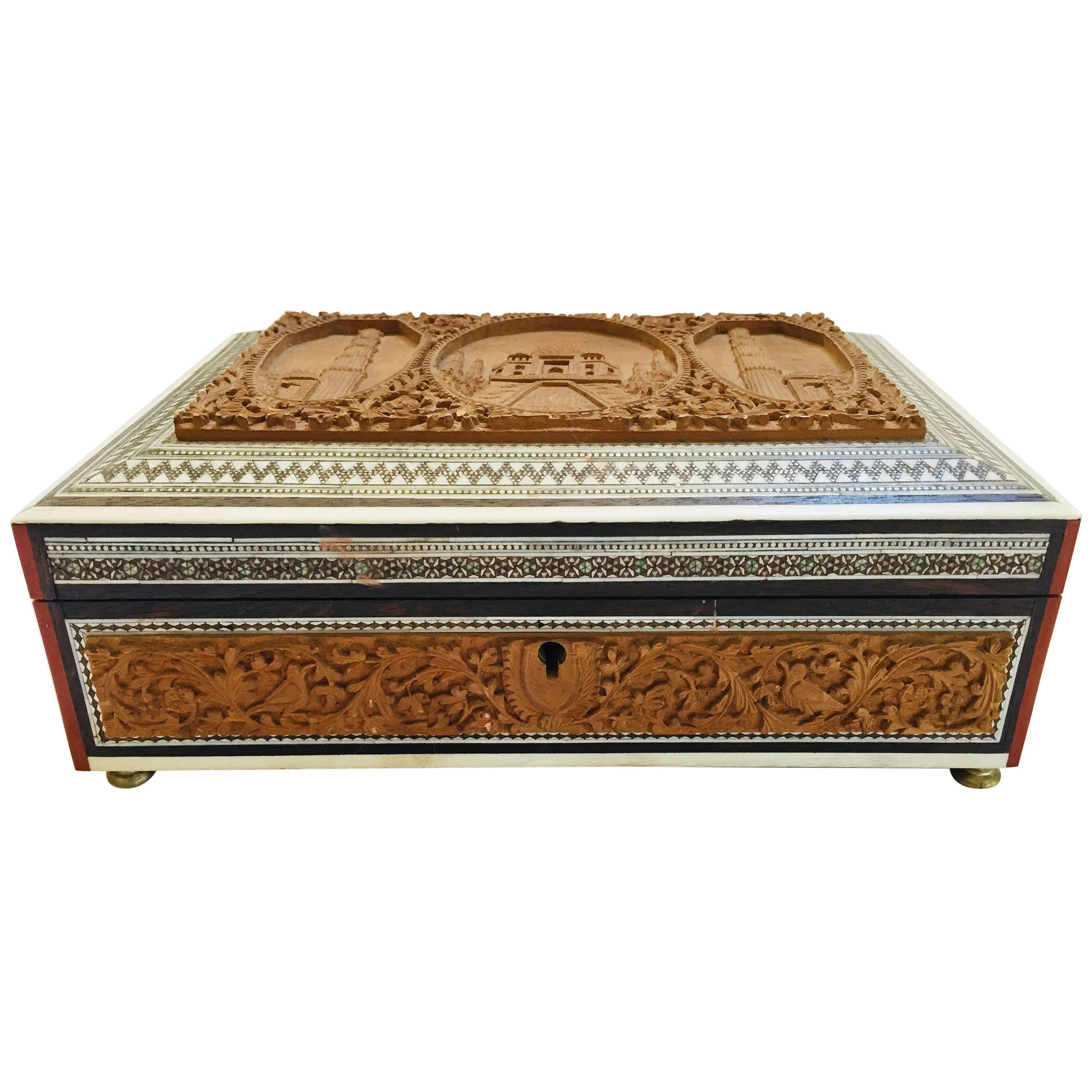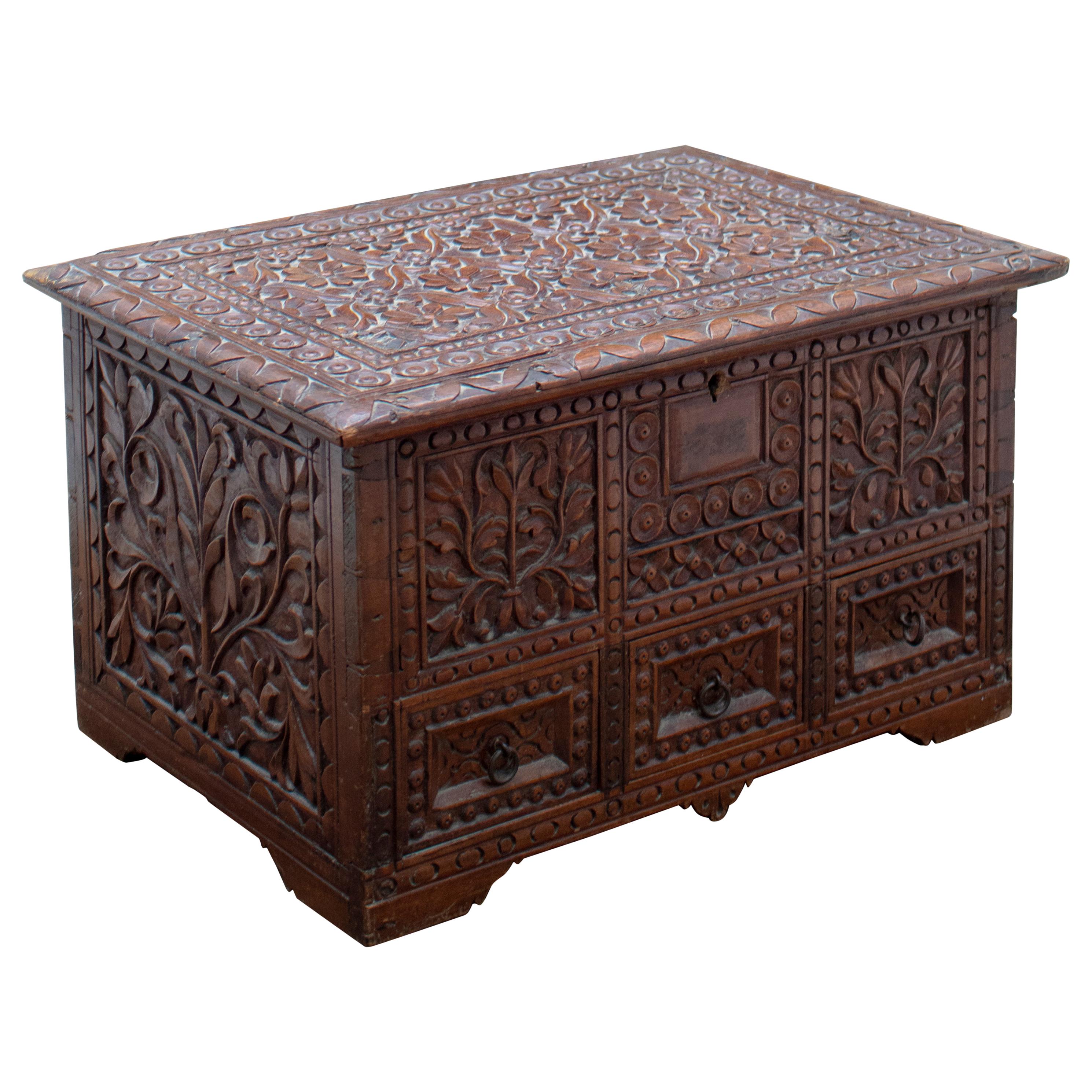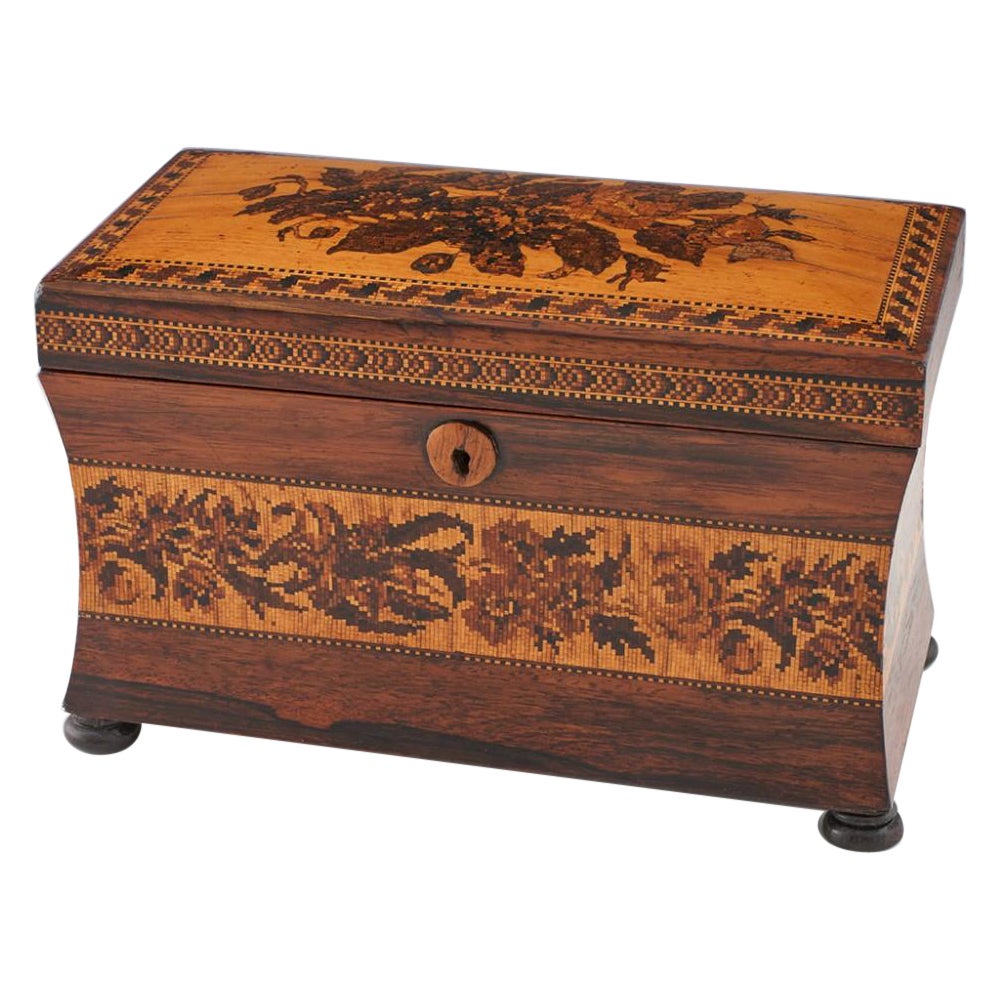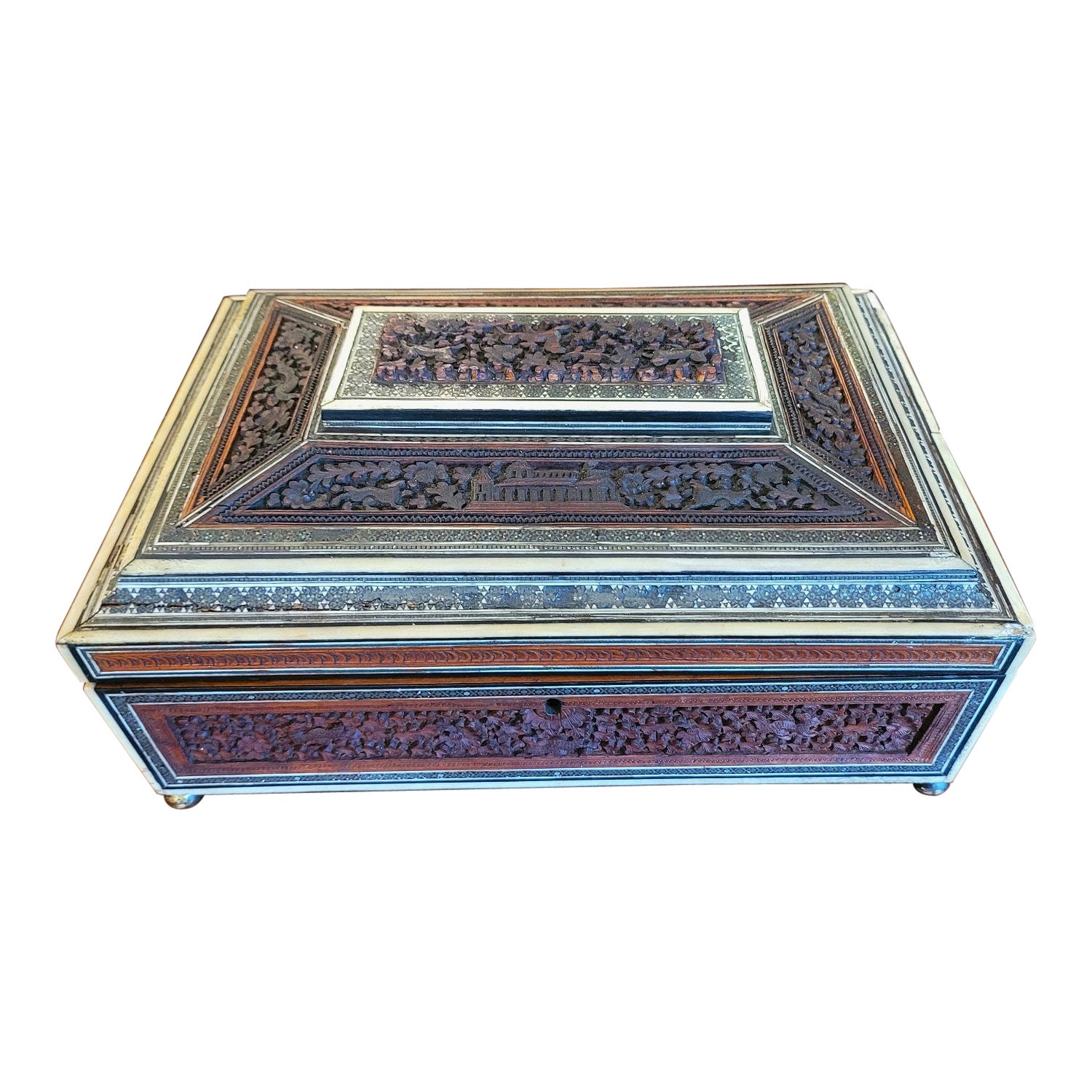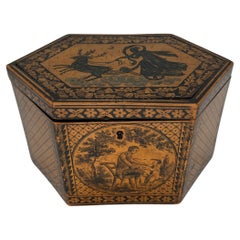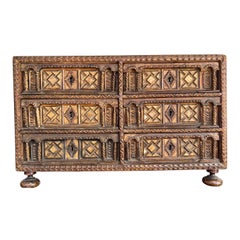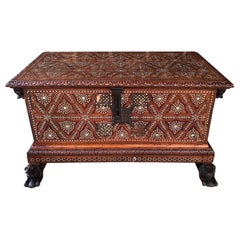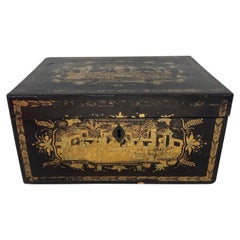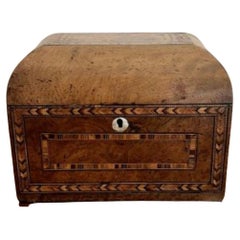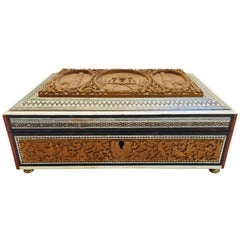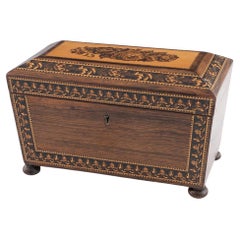Items Similar to 19th C. Anglo-Indian Hand Carved 4-Section Tea Caddy Inset W/ Tin Manganese Tile
Want more images or videos?
Request additional images or videos from the seller
1 of 11
19th C. Anglo-Indian Hand Carved 4-Section Tea Caddy Inset W/ Tin Manganese Tile
$2,895
£2,189.31
€2,507.73
CA$4,056.59
A$4,428.43
CHF 2,331.62
MX$53,047.47
NOK 29,820.62
SEK 27,226.72
DKK 18,733.35
About the Item
Anglo Indian, early 19th century.
A highly unusual Antique hand carved 4-section tea caddy. The box which features a carved ribbon edge hinged lid, which opens to reveal four individually wood lined tea boxes with brass finial handles. The body is not only beautifully carved with blooming floral designs but it is also inset with 8 classical tin Manganese Delft style tiles. Old inventory label to underside.
Provenance: From an upscale Atlanta, GA collection.
- Dimensions:Height: 7.875 in (20.01 cm)Width: 12.875 in (32.71 cm)Depth: 12.875 in (32.71 cm)
- Style:Anglo-Indian (Of the Period)
- Materials and Techniques:
- Place of Origin:
- Period:
- Date of Manufacture:19th century
- Condition:Wear consistent with age and use. Minor wear to surface of tiles. Box in great antique condition.
- Seller Location:Atlanta, GA
- Reference Number:1stDibs: LU7838238504652
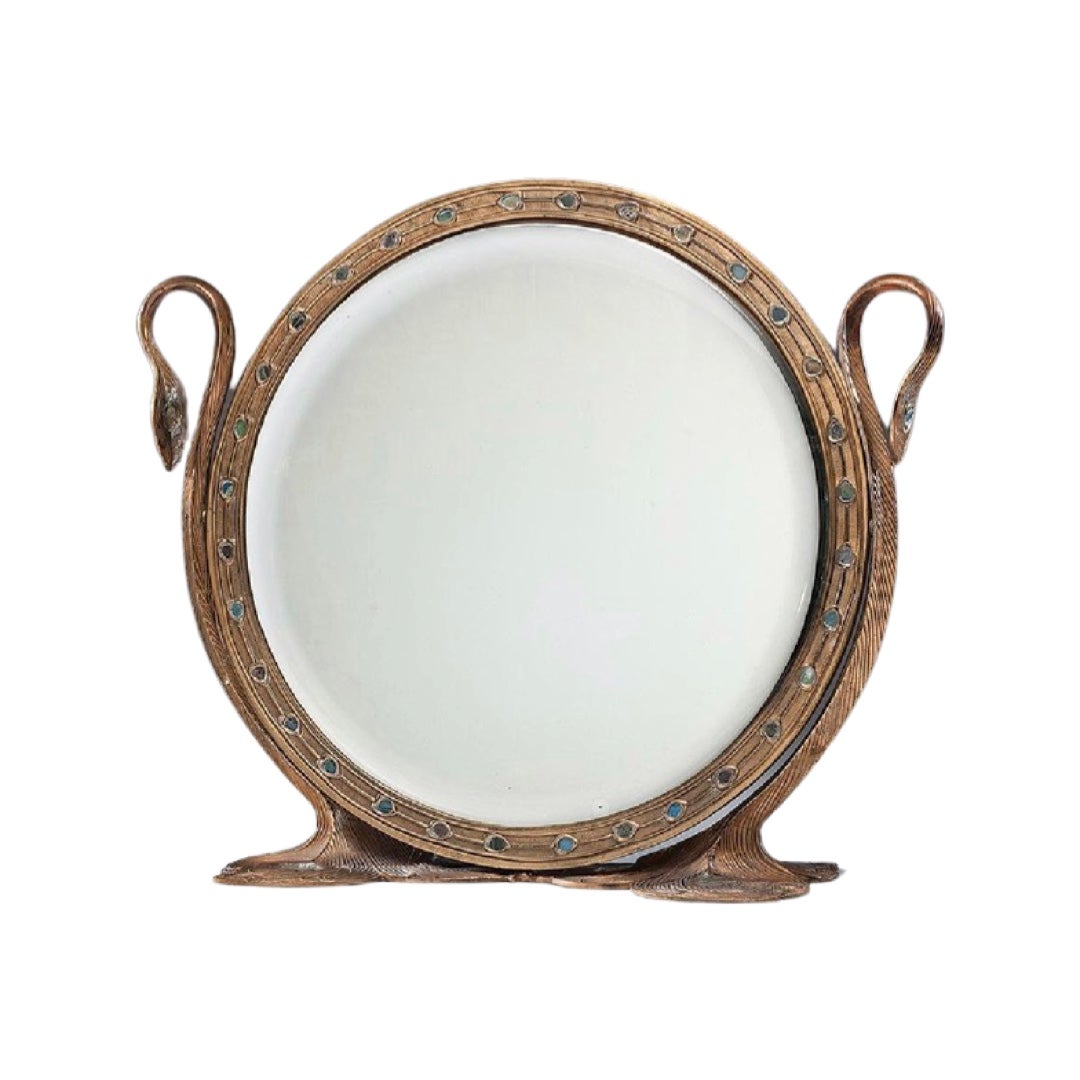
About the Seller
5.0
Platinum Seller
Premium sellers with a 4.7+ rating and 24-hour response times
Established in 2012
1stDibs seller since 2022
239 sales on 1stDibs
Typical response time: <1 hour
- ShippingRetrieving quote...Shipping from: Randolph, MA
- Return Policy
More From This Seller
View AllC. 1870 Antique English Tunbridge Ware & Penwork Regency Tea Caddy Box
Located in Atlanta, GA
English, circa 1870.
A Regency Tunbridge Ware & Penwork Tea Caddy Box of Hexagonal form. Featuring a decorated Neo Classical taste top centering the goddess Ceres recumbent upon her...
Category
Antique 19th Century English Regency Snuff Boxes and Tobacco Boxes
Materials
Walnut
18th Century, Heavily Carved Bone Inset & Iron Mounted Spanish Vargueno
Located in Atlanta, GA
Spanish, 18th century or earlier.
An 18th century Spanish bargueno or vargueno traveling desk, used for storing documents, jewels, or sewing box. The six drawer chest is inset with ...
Category
Antique 18th Century Spanish Baroque Decorative Boxes
Materials
Iron
Museum Quality 18th Century Damascus Anglo Indian Carved & Inlaid Blanket Chest
Located in Atlanta, GA
Damascus / Anglo Indian, 18th century or earlier.
The finest quality Damascus Anglo Indian blanket chest I have come across in my career. Featuring an incredible geometric bone inl...
Category
Antique 18th Century Blanket Chests
Materials
Iron
$4,716 Sale Price
20% Off
19th Century Chinese Export Lacquer Decorated Tea Caddy Box
Located in Atlanta, GA
Chinese for the English market, 19th century.
A fine quality antique Chinese export tea caddy decorated with beautiful gilding surfaces, a hinged lid which opens to reveal a tooled ...
Category
Antique 19th Century English Chinese Export Decorative Boxes
Materials
Pewter
Magnificent 19th Century Italian Grand Tour Rosewood & Bone Inlaid Cabinet
Located in Atlanta, GA
Italian, circa 1900.
A fantastic rosewood veneer and ebonized hardwood cabinet. Rectangular form with later dark green marble top, applied upper molding above a single hinged panele...
Category
Antique 19th Century Italian Anglo-Indian Cabinets
Materials
Wood
$3,840 Sale Price
20% Off
19th Century, English Mahogany & Brass Footed Divided Tea Caddy
Located in Atlanta, GA
This elegant English tea caddy is crafted from rich mahogany, showcasing the warm tones and fine grain of the wood, complemented by its brass-mounted footed details. Designed with fu...
Category
Antique 19th Century British Campaign Tea Caddies
Materials
Brass
You May Also Like
Quality antique Victorian tunbridge ware inlaid tea caddy
Located in Ipswich, GB
Quality antique Victorian tunbridge ware inlaid tea caddy having a lovely antique Victorian tunbridge ware inlaid tea caddy with beautiful detail to the box opening to reveal two rec...
Category
Antique Early 19th Century Victorian Tea Caddies
Materials
Wood
19th Century Anglo-Indian Sadeli Mosaic Jewelry Box with Lidded Compartments
Located in Moreno Valley, CA
19th century Anglo-Indian sandal wood box, Sadeli mosaic box fitted with various compartments finely hand-carved with the Taj Mahal.
Of sarcophagus form ...
Category
Antique Late 19th Century Indian Anglo-Indian Decorative Boxes
Materials
Sandalwood
Two Compartment Tunbridge Ware Tea Caddy c1860
By Tunbridge Ware
Located in Tunbridge Wells, GB
Heading : Tunbridge ware tea caddy c1860
Date : c1860
Period : Victoria
Origin : Tunbridge Wells, Kent
Decoration : Sarcophagus shape. Central floral mosaic within keylines borde...
Category
Antique 1860s British Victorian Tea Caddies
Materials
Wood
19th Century Anglo-Indian Hand Carved Tropical Wood Box
Located in Marbella, ES
19th century Anglo-Indian hand carved tropical wood box.
Category
Antique Mid-18th Century Indian Decorative Boxes
Materials
Fruitwood
Tunbridge Ware Two Compartment Sarcophagus Tea Caddy c1860
By Tunbridge Ware
Located in Tunbridge Wells, GB
Heading : Tunbridge ware sarcophagus tea caddy
Date : c1860
Period : Victoria
Origin : Tunbridge Wells, Kent
Decoration : Central floral mosaic bordered by a geometric pattern within...
Category
Antique 1860s British Tea Caddies
Materials
Wood
19C Anglo Indian Highly Carved Teak Sadeli Mosaic Inlaid Sewing Box
Located in Dallas, TX
PRESENTING A LOVELY 19C Anglo Indian Highly Carved Sadeli Mosaic Inlaid Sewing Box.
Made in Bombay, India, circa 1880.
The box is made of sandalwood with highly carved raised teak wood panels on all sides, depicting temple scenes, animals and foliage.
The box is in a sarcophagus form.
It is edged in bone (and we can tell it is bone and not ivory, from the color and evidence of capillaries, which are not found in ivory), and banded with Bombay Sadeli mosaic and ebony veneer.
The lid opens to reveal a removable tray with various open compartments and lidded compartments. 5 lidded compartments, 1 unlidded compartment and 8 holders for thimbles, etc
The tray lifts to reveal a blue velvet (original) lined section, for storing jewelry etc, with sections for collars etc.
The inside of the lid has a removable mirror (the mirror is missing on this one but can easily be replaced). Behind the mirror is the original green velvet lining.
It has its original brass carry handles on the sides and sits on 4 silvered button feet (of recent origin).
Some repairs to the exterior and condition issues (priced accordingly), but still a LOVELY COLLECTIBLE box!
These boxes were made by superb Indian craftsmen, specifically for sale to the ruling British elite. These types of boxes, carved padouk and sandalwood, (whilst beautiful and superbly crafted) were of a lesser quality, than the more profusely and intricately mosaic inlay, tortoiseshell and ivory boxes, made for the British ‘Upper Classes’ in the areas of Bombay and Vizagapatam. These type of boxes were much more affordable back in 1880 (and indeed today) and would probably have been bought by mid-level diplomats, civil servants or visitors.
Sewing boxes (in general), were in EVERY Victorian home in Britain in the 19th century and like other boxes etc were ‘status symbols’ of your place in society! The more ornate the box, the more ‘Upper Class’ you were!
SADELI MOSAIC: “Anglo Indian boxes were made in India for the English residents from the early part of the 18th century. They were brought back or sent back to England usually by the people who had commissioned them. From the beginning of the nineteenth century they were imported more commercially, although not in any significant numbers until the middle decades. They were very highly valued, especially the early ones, to the extent that the designs were copied on late 19th and early 20th century tins.
The ancient art of Sadeli Mosaic is said to have been introduced from Shiraz in Persia via Sind to Bombay, a long time before the Anglo Indian boxes were made. It was a technique, which required a high degree of skill and patience. It was executed very lavishly, in that the frequent cuts wasted a great amount of the precious materials used. The workmanship was however more than commensurable to the value of the materials.
Ivory, silver, pewter (or other metals), wood and Horn were cut into faceted rods which were bound together to form geometric patterns. When the glue has set, the rods were sliced in transverse sections. This gave the maker a number of angled circular pieces in the original pattern. Several variations of patterns could be achieved by combining the materials in different ways. The ivory was sometimes dyed green to give an extra color.
The mosaic pieces in a combination of patterns, often separated by ivory, ebony, Horn or silver stringing were used to veneer sandalwood boxes. In the early boxes, which date from the turn of the 18th to the 19th century, there are large panels of mosaic covering tops and sides of boxes. It took incredible skill to cover such large areas without any shakes or wavering of the pattern. The corners and joins on these boxes are impeccably matched.
The makers (reputed to be Persian) of Sadeli mosaic made in the first two decades of the 19th century displayed a total understanding of the qualities of the different materials they used. They combined substances, which can expand and contract according to atmospheric conditions with others, which are hard and unyielding. The result was a sharp definition of the lines and patterns, which made up the whole design.
On the early boxes the designs look deceptively simple. The fact is, they emerged from a culture, which had mastered geometry and understood how to generate a pattern from a set number of points. The patterns are so harmoniously combined that their incredible complexity is not immediately apparent.
The earliest Sadeli boxes...
Category
Antique Late 19th Century Indian Anglo-Indian Decorative Boxes
Materials
Bone, Sandalwood, Teak
More Ways To Browse
Tile 19th Century
Anglo Indian Hand Carved
Anglo Indian Carved Wood
Old Tiles
Delft Tiles Furniture
Antique Delft Tiles
Antique Wood Tea Caddy
Antique Wood Tea Caddy Boxes
Antique Brass Tea Caddy
Antique Tea Tins
Carved Indian Boxes
Delft Tobacco
Tobacco Tins
Antique Brass Snuff Box
Indian Carved Wood Box
Antique Brass Tiles
Manganese Tile
19th C Snuff Box
